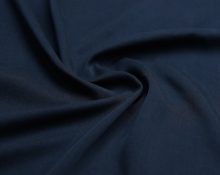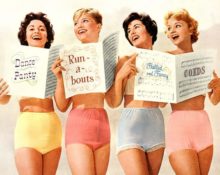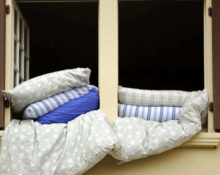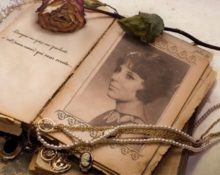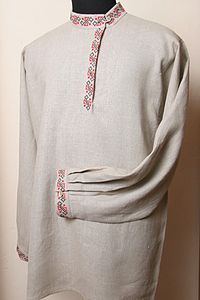
creativecommons.org
In this material we will tell you how to sew a men's shirt with your own hands. We will also share the history of this piece of clothing and describe the technique step by step for beginning craftswomen. At the end of the article you can find patterns for a shirt.
The history of the kosovorotka and why this item of clothing received such a name
Kosovorotka is a men's shirt in a traditional folk costume. Usually it is sewn from material with embroidery in the form of red patterns. Festive kosovorotki could be sewn entirely from red cloth and hand-embroidered with contrasting threads. According to tradition, even everyday men's shirts had a small decoration in the collar area.
Kosovorotki got their unusual name because of the location of the collar: the cut is not located in the front, like in ordinary shirts, but on the side on the left side. The prototype for a men's braided shirt was the so-called “straight-turned shirt”: essentially two fabrics sewn together, complemented by sleeves.It is not known for certain when exactly the kosovorotka appeared, but the first written mentions of this type of peasant clothing in chronicles date back to the 17th century. Historians suggest that the blouse was sewn back in the 15th century. It must be said that the men's kosovorotka was so comfortable that it did not disappear from the everyday life of the peasants even after the ban of Peter I came into force, who demanded that Russian traditional clothing be replaced with products of the Hungarian model (and later with French and German dresses). It was the kosovorotka that became the prototype for soldiers’ tunics.
Researchers pondered for a long time why there was a need for such a strange gate shape. It is not known for certain why peasants preferred this type of cut, but over time several possible theories have emerged.
There are four reasons for the occurrence of kosovorotka and its widespread distribution:
- The kosovorotka was borrowed from the Mongol-Tatars, who wore shirts with oblique slits.
- Ethnologist Dmitry Zelenin argued that the slanted collar of a shirt could have appeared to cover the throat from the cold wind. Here this theory has something in common with the first: since the nomadic tribes spent most of their time in the saddle, they needed to cover their throats from the wind and frost.
- Philologist and art critic Dmitry Likhachev suggested that such a cut made it possible to reliably hide the cross so that it would not jump out of the shirt during bows.
- Some historians believe that a man's blouse is an analogue of military uniform adapted for worldly needs: the chain mail was fastened on the left side (just like the blouse) and was designed to protect the neck from enemy blows. A kind of adherence to tradition.
Step-by-step master class on sewing blouses:
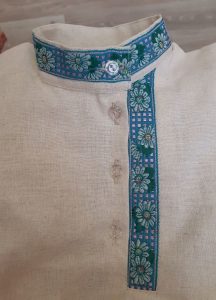
creativecommons.org
A men's blouse is considered one of the simplest shirts to make. With the help of our pattern, even a novice seamstress can sew this part of a Russian traditional costume.
To sew a men's shirt you will need:
- A piece of fabric. Traditionally, hemp fabric was used, but later it was replaced by cotton or linen. The men's blouses of the nobility were made of silk, so if you are confident in your abilities and can handle such capricious material as silk, then you can use it.
- Pattern adjusted to the required parameters.
- Sewing accessories (needle, threads of different colors for cutting and embroidery, pins, scissors).
- Decor or embroidery for subsequent decoration of the edges of the shirt. The kosovorotka was worn untucked and decorated, including in the lower part. Sometimes it was belted with a sash, a wide belt made of fabric.
The cut of the product itself will not take much time; the very shape of the shirt can be made literally in one evening. The majority of the craftswoman’s time is spent decorating the product: braid (traditionally red or blue) is the simplest option, embroidery is a more complex option.
To sew a men's shirt with your own hands:
- Adjust the pattern to the model’s parameters (height, sleeve length).
- Secure the resulting pattern with pins. You should end up with five elements of a men's shirt: the largest is the body (sometimes this part is called the frame), two sleeves, a side insert, a gusset, and decorative elements. Beginners can do without a gusset; its presence in the pattern is a kind of tribute to tradition. The presence of a gusset in a product speaks of its conventional quality and the skill of the owner.If you are sewing a men's shirt for just one event or performance, it makes no sense to include gussets in the pattern.
- Cut out all the necessary elements, retreating 1-1.5 cm from the edge.
- Connect the frame and side parts.
- Sew the sleeves to the resulting element, leaving room for a gusset if you decide to make one.
- Finish the edges of the collar by decorating it with embroidery (counted satin stitch, cross stitch or chain stitch) or braid.
- You can decorate the sleeves and the bottom of the men's shirt with the remaining part of the braid or embroidery.


 0
0